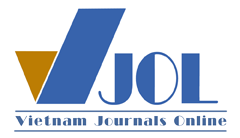Study on the ability to treat methylene blue in water and textile dyeing wastewater from sedge mats of the ZnAlCO3 hydrotalcite modified by Cu2+ ion under visible light
DOI:
https://doi.org/10.51316/jca.2023.044Keywords:
Hydrotalcite, photocatalyst, photodegradation, methylene blue, possible mechanismAbstract
Hydrotalcite ZnAlCO3 and modified hydrotalcite CuZnAlCO3 were synthesized by a co-precipitation method from nitrate salts of Al, Zn and Cu as precursors. Using Na2CO3 salt to provide CO32- interlayer ion and NaOH 2N solution to adjust the pH of the reaction mixture to pH = 9.5. The obtained samples were characterized by physical analysis methods: XRD, EDX, SEM image, BET, UV-Vis DRS. The characterization results showed that the two synthesized samples H and 3CuH (molar ratio of Zn:Al and Cu:Zn:Al are 7:3 and 3:4:3 for H and 3CuH, respectively) had a lamellar structure similar to hydrotalcite with ions CO32- in the interlayer. The molar ratio of Zn:Al and Cu:Zn:Al in the samples is quite similar to the amount taken to synthesize the samples. The specific surface area increased from 16.1 to 33.9 m2/g, while the band gap energy Eg decreased from 3.02 to 1.25 eV, corresponding to H and 3CuH. The photocatalytic activity of the 3CuH sample in the decomposition reaction of methylene blue (MB) was much better than that of the sample H at the concentrations of MB investigated (10, 25, 50 ppm). The catalytic activity of the 3CuH material depended on the initial concentration of MB solution and the pH of the medium. Free radicals OH• and holes h+ play an important role in the photocatalytic activity of 3CuH material. In addition, the 3CuH sample is capable of effectively treating blue sedge textile dyeing wastewater with the decomposition efficiency of blue substances reaching over 94% after 4 hours of illumination, the mineralization efficiency of pigments reaching nearly 88% after 7 hours of lighting.
Downloads
References
Hao Sun, Young-Jung Heo, Ji-Hye Park, Kyong Yop Rhee, and Soo-Jin Park, Nanotechnology Reviews (2020) 1381–1396. https://doi.org/10.1515/ntrev-2020-0102.
Syamone Somxayasine, Vu Van Nhuong, Nguyen Quoc Dung, TNU Journal of Science and Technology 225(9) (2020) 3-10. https://doi.org/10.34238/tnu-jst.2840.
Phạm Thị Hà Thanh, Nguyễn Quốc Dũng, Lê Thị Phương, Vũ Văn Nhượng, Vietnam Journal of Catalysis and Adsorption, 10 – special issue 1 (2021) 252-258.
https://doi.org/10.51316/jca.2021.135.
Van Nhuong Vu, Thi Ha Thanh Pham, Maiboun Chanthavong, Tra Huong Do, Thi Hien Lan Nguyen, Quoc Dung Nguyen and Thi Kim Ngan Tran, Inorganics 10 (2022) 89. https://doi.org/10.3390/inorganics10070089.
Van Nhuong Vu, Thi Ha Thanh Pham, Quoc Dung Nguyen, Thi Hau Vu, Thi Tu Anh Duong, Thi Hue Tran and Thi Kim Ngan Tran, Processes 10 (2022) 1555. https://doi.org/10.3390/pr10081555.
Nguyen Tien Thao, Le Thi Kim Huyen, Chemical Engineering Journal 279 (2015) 840–850. http://dx.doi.org/10.1016/j.cej.2015.05.
Yaxin Zhang, Chenhui Zhang, Zicheng Zhou, Yinsu Wu, Shengtao Xing, Journal of Environmental Chemical Engineering 9 (2021) 106178. https://doi.org/10.1016/j.jece.2021.106178.
Xin Nie, Guiying Li, Shanshan Li, Yingmei Luo, Wenming Luo, Quan Wan, Taicheng An, Applied Catalysis B: Environmental 300 (2022) 120734. https://doi.org/10.1016/j.apcatb.2021.120734.
Xiaojiao Yu, Jie Zhang, Jian Zhang, Jinfen Niu, Jie Zhao, Yuchen Wei, Binghua Yao, Chemical Engineering Journal 374 (2019) 316–327. https://doi.org/10.1016/j.cej.2019.05.177.
Mohamed Hammad Elsayed, Taha M. Elmorsi, Ahmed M. Abuelela, Ahmed E. Hassan, Ahmed Zaki Alhakemy, Mostafa F. Bakr , Ho-Hsiu Chou, Journal of the Taiwan Institute of Chemical Engineers 115 (2020) 187-197. https://doi.org/10.1016/j.jtice.2020.10.018.











